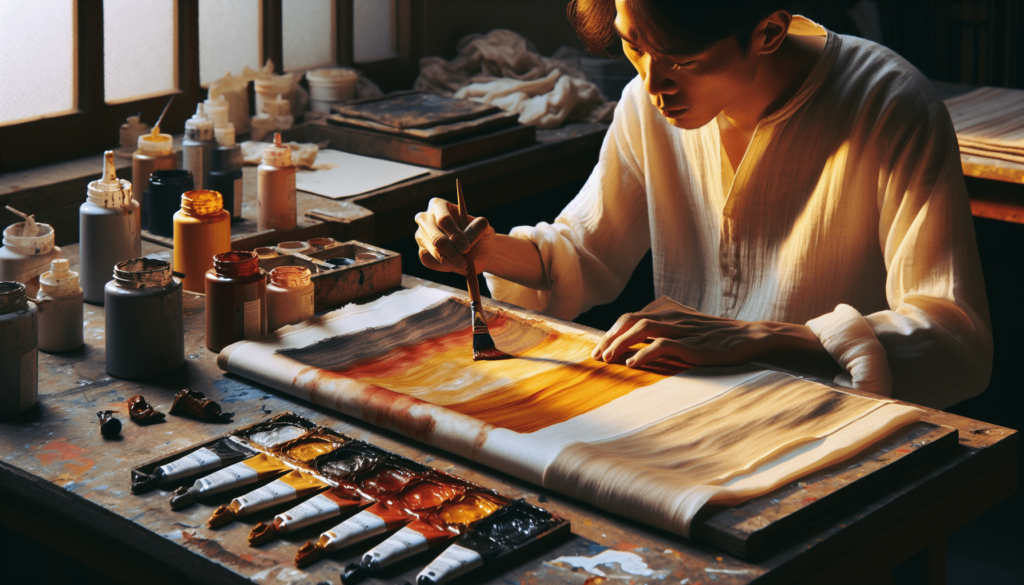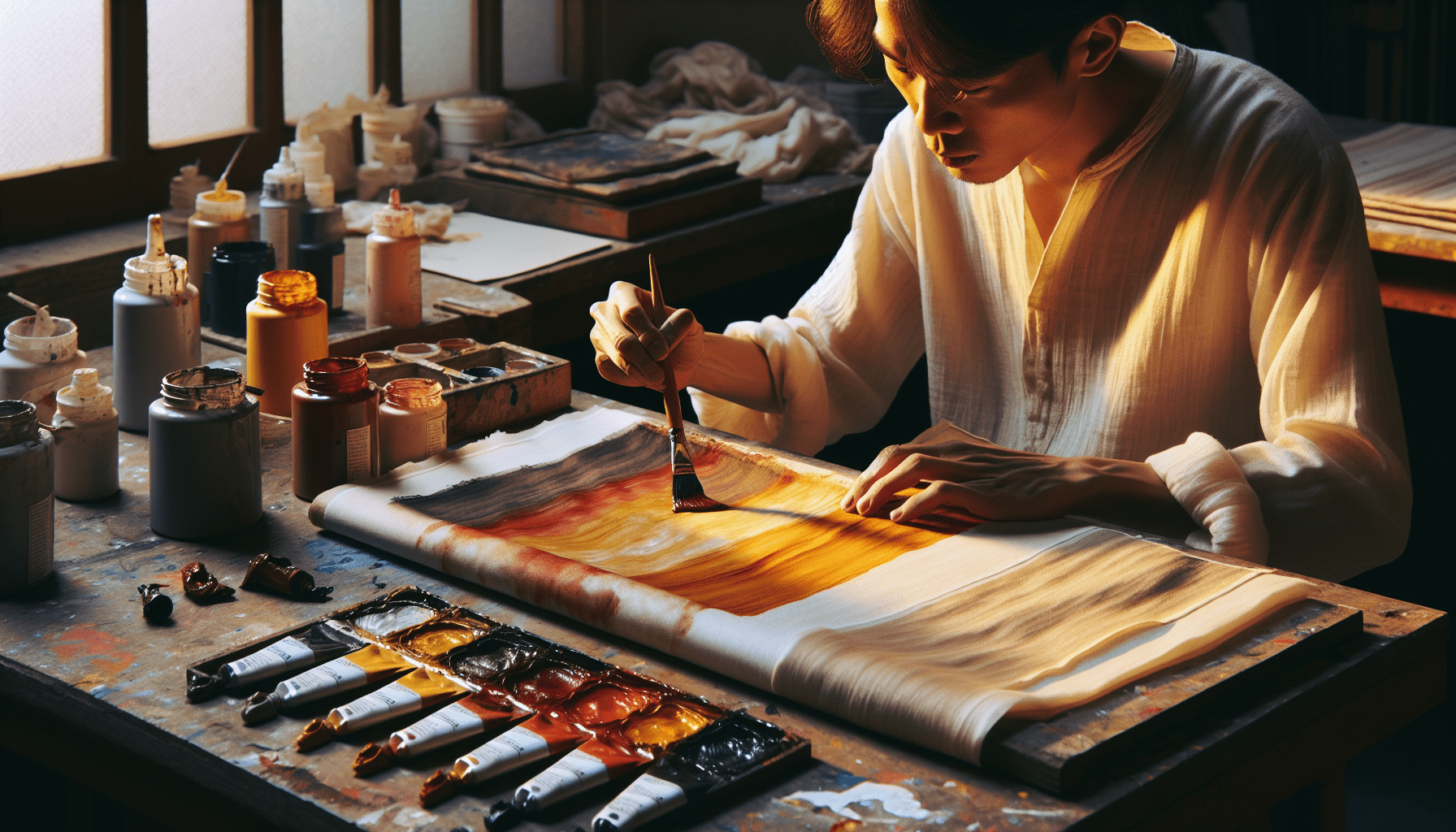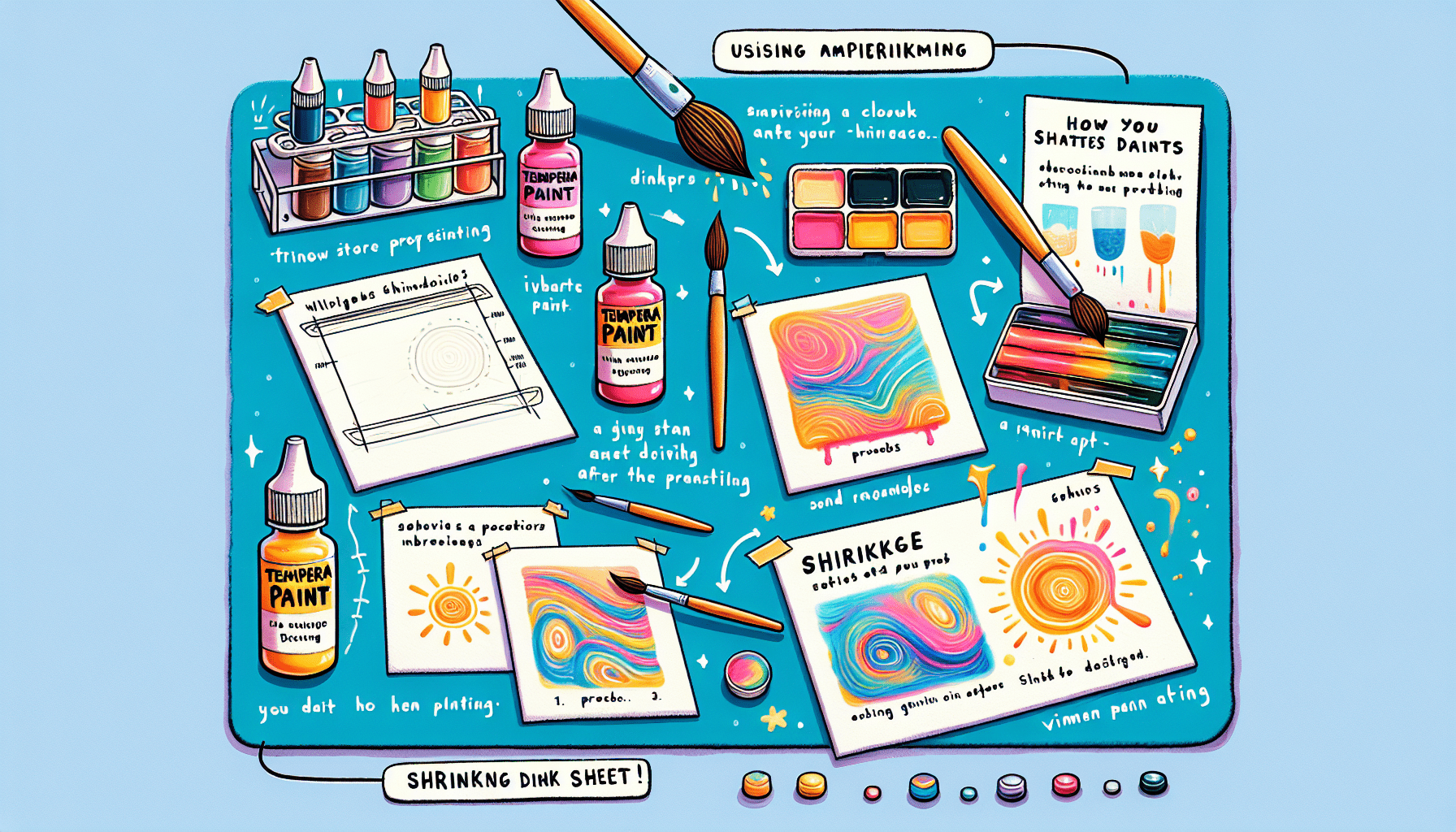In the quest to explore new artistic mediums, many individuals find themselves wondering if tempera paint can be effectively used on fabric. This article aims to provide you with a comprehensive answer to this query by examining the properties of tempera paint and its compatibility with fabric materials. By delving into the subject, we hope to equip you with the knowledge needed to make informed decisions when it comes to creating textile art with tempera paint.

What is Tempera Paint?
Definition of Tempera Paint
Tempera paint, also known as poster paint, is a water-based paint that is used widely in various art projects, including painting on fabric. It is made by combining pigments with a binding agent, such as egg yolk or gum Arabic, which gives it a smooth and even consistency. Tempera paint has been used for centuries and is known for its vibrant and opaque colors.
Properties of Tempera Paint
Tempera paint has several properties that make it suitable for various artistic endeavors, including painting on fabric. It dries quickly, allowing artists to layer colors without waiting for extended periods. It has a matte finish, which gives a unique look to fabric paintings. Furthermore, tempera paint is non-toxic and safe to use, making it ideal for artists of all ages.
Typical Uses of Tempera Paint
Tempera paint is commonly used in a range of art applications, including canvas painting, murals, paper projects, and even fabric painting. It is often used by both professional artists and beginners due to its versatility and affordability. When used on fabric, tempera paint can add color, patterns, and designs, allowing for creative and unique clothing, home decor, and textile projects.
Types of Fabric
Different Types of Fabric
There are various types of fabric available in the market, each with its own unique characteristics and properties. Some common types of fabric include cotton, polyester, silk, linen, and nylon. Cotton is a popular choice for fabric painting due to its breathability, ability to hold color well, and easy availability. Polyester fabrics also work well with tempera paint, as they are durable and colorfast.
Suitable Fabrics for Tempera Paint
While tempera paint can be used on various fabrics, some fabrics are more suitable than others. Fabrics with a tight weave, such as cotton and polyester, tend to work best as they provide a smooth surface for the paint to adhere to. Fabrics with a looser weave, like silk and linen, may require extra precautions or treatment to prevent bleeding and feathering of the paint.
Can Tempera Paint be Used on Fabric?
Pros of Using Tempera Paint on Fabric
Using tempera paint on fabric offers several advantages. Firstly, tempera paint is affordable and easily accessible, making it a popular choice for artists on a budget. Secondly, it comes in a wide range of vibrant colors and can be easily mixed to achieve the desired shades, allowing artists to unleash their creativity. Additionally, tempera paint dries quickly, which is beneficial when working on fabric projects with multiple layers or intricate designs.
Cons of Using Tempera Paint on Fabric
While tempera paint can be used on fabric, there are some drawbacks to consider. One limitation is that tempera paint is not as flexible as fabric paints or dyes, which may cause cracking or flaking on certain fabrics, especially those that stretch or move frequently. Another disadvantage is that tempera paint may not withstand repeated washing or exposure to moisture, resulting in color fading or bleeding. Therefore, it may not be suitable for fabric items that require frequent laundering or for projects intended for long-term use.
Preparing Fabric for Tempera Paint
Washing and Drying the Fabric
Before applying tempera paint to fabric, it is important to prep the fabric properly. Start by washing the fabric using a gentle detergent to remove any dirt, chemicals, or sizing that may be present. Follow the care instructions specific to the fabric type. After washing, ensure the fabric is thoroughly dried to prevent any moisture from affecting the paint application.
Using a Primer or Gesso
To enhance the adhesion and longevity of tempera paint on fabric, using a primer or gesso can be beneficial. Apply a thin layer of primer or gesso to the fabric surface and let it dry completely before painting. This will create a smooth and even surface, preventing the paint from seeping into the fabric’s fibers and allowing it to adhere better.
Stretching or Taping the Fabric
To ensure a smooth painting experience, it is recommended to stretch the fabric taut or secure it tightly using tape on a painting surface. This will prevent the fabric from wrinkling or moving during the painting process, resulting in more precise and controlled brushstrokes. It is important to secure the fabric without stretching it too tightly, as this may distort the fabric’s weave and affect the final appearance of the painting.

Applying Tempera Paint on Fabric
Choosing the Right Brushes
When painting with tempera on fabric, it is important to select the appropriate brushes for the desired effect. Synthetic brushes, such as those made with nylon or polyester bristles, are often recommended for fabric painting as they are durable and can withstand the texture of the fabric. Flat brushes are commonly used for larger areas and filling in backgrounds, while round brushes are suitable for finer details and intricate designs.
Applying the Paint
Before starting, it is advisable to sketch the design lightly on the fabric using a pencil or chalk, especially for more complex compositions. Begin by applying a thin layer of paint onto the fabric, gradually building up the colors and layers as needed. It is important to let each layer dry before applying the next to prevent smudging or creating muddy colors. Applying the paint in thin, even layers will help maintain the fabric’s flexibility and prevent cracking or flaking.
Blending and Layering Colors
One of the advantages of using tempera paint on fabric is the ability to blend and layer colors. To achieve smooth transitions between colors or create depth in the artwork, gently blend the colors together using a brush or a dry cloth. Layering different shades of paint can also create interesting effects and textures. Experiment with different techniques and explore the medium’s versatility to achieve the desired visual impact.
Fixing Tempera Paint on Fabric
Heat Setting
After completing the painting, it is crucial to fix the tempera paint on the fabric to improve its durability and make it more resistant to washing and general wear. One common method is heat setting. Place a pressing cloth or a piece of fabric over the painted area and iron it on a low heat setting. The heat helps set the paint into the fabric, making it more permanent. Avoid using high heat or steam, as it may damage the fabric or cause the paint to smudge.
Ironing
Ironing the painted fabric on a low heat setting can also help in fixing the tempera paint. Ensure that the painting is completely dry before ironing and place a pressing cloth or piece of fabric between the iron and the artwork to prevent direct contact. Gently press the iron in a circular motion over the painted areas, moving it slowly to allow the heat to penetrate the fabric and set the paint.
Using Fabric Medium
Another option to fix tempera paint on fabric is by using a fabric medium. Fabric mediums are specially formulated substances that can be mixed with tempera paint to enhance its adherence to fabric. Follow the instructions provided with the fabric medium and mix it with the tempera paint according to the recommended ratios. Apply the paint as usual, and once dry, heat set the fabric using an iron or by placing it in a dryer on a low heat setting.
Caring for Fabric Painted with Tempera
Washing and Drying Instructions
To ensure the longevity of fabric painted with tempera, proper care is essential. Always follow the care instructions provided by the fabric manufacturer. When washing, turn the painted fabric inside out to protect the artwork and place it in a gentle cycle with cold water. Avoid using harsh detergents or bleaching agents, as they can fade or damage the paint. After washing, let the fabric air dry or tumble dry on a low heat setting.
Avoiding Harsh Detergents or Bleach
When washing fabric painted with tempera, it is important to steer clear of harsh detergents or bleach, as they can affect the color and integrity of the paint. Look for mild, gentle detergents specifically formulated for delicate fabrics or those that mention suitability for painted fabrics. These detergents are typically milder and less likely to cause fading or damage to the paintwork.
Storing the Fabric
To preserve fabric painted with tempera, proper storage is crucial. Ensure the fabric is completely dry before storing it to prevent any moisture buildup that may lead to mold or mildew growth. Store the fabric in a cool, dry place away from direct sunlight, as prolonged exposure to sunlight can cause color fading. If possible, roll the fabric instead of folding it to prevent creases that may damage the paint over time.
Alternative Paint Options for Fabric
Fabric Paints
Fabric paints are specifically formulated for painting on fabrics and offer excellent adhesion and flexibility. Unlike tempera paint, fabric paints are designed to withstand repeated washing and exposure to moisture. They offer a wider range of colors, including metallic and glow-in-the-dark options, and often come in convenient squeeze bottles or markers for easy application.
Acrylic Paints
Acrylic paints are a popular choice for fabric painting due to their versatility and wide range of colors. They are water-based and offer good adhesion to fabric when heat set or when used with a fabric medium. Acrylic paints provide a more durable finish compared to tempera paint and are suitable for fabric projects that require regular washing or are intended for long-term use.
Fabric Dyes
Fabric dyes, such as tie-dye or fiber-reactive dyes, are another option for coloring fabric. Unlike paints, fabric dyes penetrate the fabric’s fibers, resulting in vibrant and long-lasting colors. They offer excellent color fastness and can withstand multiple washings without fading or bleeding. Fabric dyes work best on natural fibers, such as cotton or silk, and can create unique patterns and designs.
Creative Ideas for Using Tempera Paint on Fabric
T-shirts and Clothing
Tempera paint can be used to transform plain t-shirts and clothing into one-of-a-kind wearable art pieces. Whether you want to create a bold design or a subtle pattern, the versatility of tempera paint allows for endless possibilities. Personalize t-shirts, hoodies, or even jeans with your own hand-painted designs, making a fashion statement that reflects your creativity and individuality.
Canvas Bags and Tote Bags
Canvas bags and tote bags are popular choices for fabric painting, and tempera paint can be an excellent medium to add color and personality to these accessories. Whether you prefer a minimalist design or a vibrant masterpiece, painting canvas bags with tempera paint allows you to create functional art that expresses your style while being environmentally friendly.
Home Decor and Textiles
Tempera paint can be used to revamp and personalize various home decor and textiles. Transform plain throw pillows, curtains, tablecloths, and even lampshades with unique and vibrant designs. By painting with tempera, you can add a touch of artistry to your living space, making it more inviting and reflecting your personal taste.
Tips and Tricks for Using Tempera Paint on Fabric
Testing on a Small Swatch
Before starting a large fabric painting project, it is essential to test the tempera paint on a small swatch of fabric. This will help you determine how the paint interacts with the fabric and allow you to adjust your techniques or color choices if needed. It is also an opportunity to experiment with blending colors or layering techniques without the risk of ruining the entire project.
Watering Down the Paint
Tempera paint can be watered down to achieve different effects on fabric. Adding a small amount of water to the paint can create a transparent or stained-glass-like effect. This technique works well for light washes or creating a watercolor-like appearance. Experiment with different levels of dilution to achieve the desired intensity and transparency of the paint.
Using Stencils or Templates
If you are new to fabric painting or want to create precise designs, using stencils or templates can be incredibly helpful. Stencils allow for consistent and accurate shapes, while templates provide guidelines for freehand designs. Apply the stencil or template onto the fabric and use a brush or sponge to fill in the desired areas with tempera paint. This technique ensures clean lines and is particularly useful for intricate or detailed designs.
In conclusion, tempera paint can indeed be used on fabric, offering a cost-effective and versatile medium for creating unique and colorful designs. With the right preparation and care, fabric painted with tempera can withstand regular use and washing. While there are some limitations to consider, such as paint flexibility and long-term durability, tempera paint remains a popular choice for a wide range of fabric projects. Explore your creativity, follow the provided tips and tricks, and enjoy the process of creating beautiful fabric art with tempera paint.



